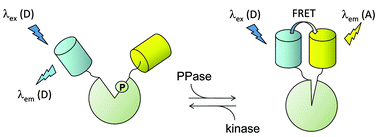Visualization of phosphatase activity in living cells with a FRET-based calcineurin activity sensor†‡
Abstract

* Corresponding authors
a
Department of Pharmacology and Molecular Sciences, The Johns Hopkins University School of Medicine, Baltimore, USA
E-mail:
jzhang32@jhmi.edu
Fax: (410)955-3023
Tel: (410)502-0713
b The Solomon H. Snyder Department of Neuroscience and Department of Oncology, The Johns Hopkins University School of Medicine, 725 N. Wolfe St., Baltimore, USA

 Please wait while we load your content...
Something went wrong. Try again?
Please wait while we load your content...
Something went wrong. Try again?
R. H. Newman and J. Zhang, Mol. BioSyst., 2008, 4, 496 DOI: 10.1039/B720034J
To request permission to reproduce material from this article, please go to the Copyright Clearance Center request page.
If you are an author contributing to an RSC publication, you do not need to request permission provided correct acknowledgement is given.
If you are the author of this article, you do not need to request permission to reproduce figures and diagrams provided correct acknowledgement is given. If you want to reproduce the whole article in a third-party publication (excluding your thesis/dissertation for which permission is not required) please go to the Copyright Clearance Center request page.
Read more about how to correctly acknowledge RSC content.
 Fetching data from CrossRef.
Fetching data from CrossRef.
This may take some time to load.
Loading related content
